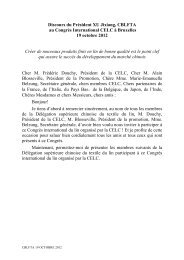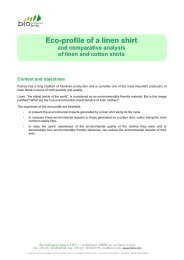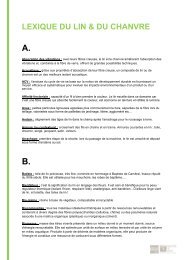Le fil du lin & du chanvre âââ n°03 - Masters of Linen
Le fil du lin & du chanvre âââ n°03 - Masters of Linen
Le fil du lin & du chanvre âââ n°03 - Masters of Linen
Create successful ePaper yourself
Turn your PDF publications into a flip-book with our unique Google optimized e-Paper software.
CELC<br />
Lin et <strong>chanvre</strong>,<br />
les boucliers écologiques<br />
———<br />
Par Catherine Dauriac<br />
« Nous éliminons aujourd’hui plus de mille fois plus d’espèces qu’avant l’époque in<strong>du</strong>strielle.<br />
Cette extinction massive, la sixième dans l’histoire de la Terre, l’humanité en est la cause. Elle<br />
pourrait en être la victime. » Hubert Reeves, astrophysicien<br />
“Today we are eliminating over a thousand times more species than before the in<strong>du</strong>strial era.<br />
This massive extinction, the 6th in the Earth’s history, is caused by humans. And humanity<br />
may be the victim as well.” Hubert Reeves, astro-physicist<br />
L’Organisation des Nations Unies a déclaré 2010 Année Internationale de la Biodiversité. Quand<br />
la conservation de la diversité biologique devient une préoccupation mondiale, le <strong>lin</strong> et le <strong>chanvre</strong><br />
s’affirment plus que jamais comme les fibres de demain.<br />
The United Nations Organization has declared 2010 the International Year <strong>of</strong> Biodiversity. As the conservation<br />
<strong>of</strong> biological diversity becomes a worldwide preoccupation, flax and hemp, more than ever,<br />
are confirmed as fibers for tomorrow.<br />
Biodiversité. Ce néologisme, apparu en 1988, recouvre l’ensemble des formes de vie sur Terre – la<br />
faune, la flore, les milieux naturels mais aussi l’espèce humaine – et les relations établies entre elles.<br />
Préserver la biodiversité, c’est donc préserver les espèces, les écosystèmes et tout ce qu’ils peuvent<br />
apporter à l’humanité ; c’est concevoir une utilisation <strong>du</strong>rable des ressources en protégeant la vie.<br />
L’Europe est le berceau d’un ensemble unique d’écosystèmes. <strong>Le</strong> moindre voyage en train permet<br />
d’embrasser <strong>du</strong> regard la richesse de ses terroirs, la beauté douce et la diversité de ses paysages…<br />
Biodiversity. This term, which first appeared in 1988, covers all life forms on Earth – fauna, flora and<br />
natural environments as well as the human race – and the relationship between them. Preserving<br />
biodiversity means preserving species, ecosystems and all they <strong>of</strong>fer humanity. It means conceiving<br />
the sustainable use <strong>of</strong> resources while protecting life. Europe is the cradle <strong>of</strong> a unique group <strong>of</strong><br />
ecosystems. Even on the shortest train trip we can see the s<strong>of</strong>t beauty and diversity <strong>of</strong> Europe’s rich<br />
terrains and landscapes…<br />
Lin et <strong>chanvre</strong>. L’Europe est aussi le berceau de la culture <strong>du</strong> <strong>lin</strong> et <strong>du</strong> <strong>chanvre</strong>, fruits d’une <strong>fil</strong>ière<br />
active et solidaire, héritière de savoirs précieusement transmis au <strong>fil</strong> <strong>du</strong> temps. La main de l’homme<br />
est bel et bien au cœur <strong>du</strong> process. S’il est urgent, aujourd’hui, de repenser nos façons de consommer,<br />
en privilégiant les technologies de pointe s’appuyant sur des ressources renouvelables, le <strong>lin</strong><br />
et le <strong>chanvre</strong> ont un rôle leader dans ce défi universel. Culture ancestrale issue des savoir-faire de<br />
toute une <strong>fil</strong>ière, ils sont garants d’un équilibre salutaire pour la préservation de nos terroirs, faune<br />
et flore incluses. Au stade de la culture, ils sont protecteurs et fertilisants, ne réclament ni pesticide,<br />
ni irrigation, ne rejettent aucun défoliant tout en participant – cerise sur le gâteau climatique – au<br />
stockage <strong>du</strong> carbone émis dans l’atmosphère. Au stade <strong>du</strong> rouissage, première transformation de la<br />
plante en fibre par une action enzymatique des éléments naturels en plein champs, ils sont <strong>fil</strong>s <strong>du</strong><br />
vent et de la pluie. C’est le teillage, antépénultième métamorphose mécanique, qui leur permettra de<br />
danser sur un <strong>fil</strong> d’argent. Au stade de leur transformation finale, ils inspirent la recherche in<strong>du</strong>strielle<br />
et la créativité des designers bien au-delà désormais de leurs applications textiles traditionnelles. <strong>Le</strong><br />
<strong>lin</strong> et le <strong>chanvre</strong>, fibres ancestrales et visionnaires à la fois, font ainsi leur part <strong>du</strong> colibri *. Parents<br />
pauvres des Trente Glorieuses sous le sacro-saint règne de l’hydrocarbure, on s’accorde aujourd’hui<br />
à leur trouver toutes les qualités environnementales requises, bien-être et beauté en sus. La roue <strong>du</strong><br />
mou<strong>lin</strong> tourne, l’eau coule sous les ponts et la planète reprend son souffle…<br />
Flax and hemp. Europe is also the cradle <strong>of</strong> flax and hemp cultivation, the fruit <strong>of</strong> an active, interdependent<br />
in<strong>du</strong>stry which has inherited precious knowledge that has been transmitted over the<br />
generations. The hand <strong>of</strong> man is at the heart <strong>of</strong> this process. If today it is urgent to rethink how we<br />
consume, by privileging the newest technologies which rely on renewable resources, flax and hemp<br />
have a leading role in this universal challenge. An ancestral cultivation drawn from the know-how<br />
<strong>of</strong> an entire in<strong>du</strong>stry, they guarantee a beneficial balance to preserve land, flora and fauna. At the<br />
cultivation stage, they protect and self-fertilize, need neither pesticides nor irrigation, aren’t effected<br />
by defoliants and – as a climatic ‘cherry on the cake’ – help stock CO 2 emitted into the atmosphere.<br />
During the retting stage, the first transformation <strong>of</strong> the plant into fibers using enzymes from natural<br />
elements which is done in the fields, they interact with wind and rain. Scutching, the next-to-the-last<br />
mechanical metamorphosis, allows them to ‘dance on a silver thread’. For their final transformation,<br />
they inspire in<strong>du</strong>strial researchers and creative designers for uses that go well beyond traditional<br />
textile applications. Flax and hemp fibers, both ancestral and visionary, play the role <strong>of</strong> a hummingbird<br />
*. As poor descendents <strong>of</strong> the Glorious 30’s sacred hydro-carbons, we discover their many<br />
environmental qualities which also <strong>of</strong>fer us well-being and beautiful pro<strong>du</strong>cts. The mill wheel turns,<br />
water flows under the bridge and the planet can breathe again…<br />
*La légende <strong>du</strong> colibri<br />
Un jour, dit la légende, il y eut un immense incendie de forêt. Tous les animaux terrifiés observaient<br />
impuissants le désastre. Seul le petit colibri s’activait, allant chercher quelques gouttes d’eau dans son<br />
bec pour les jeter sur le feu. Au bout d’un moment, le tatou, agacé par ses agissements dérisoires, lui<br />
dit « Colibri ! Tu n’es pas fou ! Tu crois que c’est avec ces gouttes d’eau que tu vas éteindre le feu ? ! »<br />
<strong>Le</strong> colibri lui répondit alors : « Je le sais, mais je fais ma part ». La légende raconte que chaque animal<br />
se sentit concerné, que chacun fit sa part et que la forêt fut sauvée ! Telle est notre responsabilité à<br />
l’égard <strong>du</strong> monde car nous ne sommes pas totalement impuissants.<br />
*The hummingbird legend<br />
One day, according to legend, there was a huge fire in the forest. All the terrified animals observed<br />
the disaster helplessly. Only the tiny hummingbird remained busy, finding a few drops <strong>of</strong> water and<br />
carrying it in his beak to throw on the fire. After a time, the armadillo, annoyed by his ridiculous<br />
movements said “Hummingbird? You are crazy! Do you think you will put out the fire with these few<br />
drops <strong>of</strong> water?!” The hummingbird answered: “I know, but I’m doing what I can”. <strong>Le</strong>gend says that<br />
each animal was then inspired to do his part and the forest was saved! That is our responsibility to<br />
the world since we are not totally helpless.<br />
————<br />
Comment agir ? <strong>Le</strong>s Nations Unies veulent donner un nouveau souffle à la lutte contre la perte<br />
de biodiversité et sensibiliser tous les publics. Une série de manifestations est prévue toute l’année.<br />
<strong>Le</strong> portail français de l’Année Internationale de la Biodiversité propose un agenda et une labellisation<br />
des projets (www.biodiversite2010.fr). Site d’information de l’ONU : www.cbd.int/2010<br />
————<br />
How to react? The United Nations wants to give a new breath <strong>of</strong> air to fight the loss <strong>of</strong> biodiversity<br />
and sensitize the general public. A series <strong>of</strong> events is planned throughout the year. The French<br />
portal for the International Year <strong>of</strong> Biodiversity proposes an agenda citing various projects (www.<br />
biodiversité2010.fr). United Nations information web site: www.cbd.int/2010<br />
Lin Européen<br />
Plante aut<strong>of</strong>éconde / autogame<br />
Peu d’intrants, pas d’irrigation<br />
Pas de rejets de défoliants<br />
Excellente tête d’assolement (absorbe l’azote)<br />
Compensation CO 2 / an = 16 T / ha<br />
(la pro<strong>du</strong>ction d’une famille de 4 personnes)<br />
Zéro déchet<br />
85% de la culture mondiale de <strong>lin</strong><br />
est réalisée en Europe<br />
European <strong>Linen</strong><br />
A self-fertilizing / self-sufficient plant<br />
Little care and no irrigation needed<br />
No defoliants rejected back into the environment<br />
Excellent nitrogen absorbtion<br />
CO 2 compensation per year = 39,5 tons/acre<br />
(amount pro<strong>du</strong>ced by a 4-person family)<br />
Zero waste<br />
85% <strong>of</strong> world flax growth takes<br />
place in Europe<br />
— 22 —







